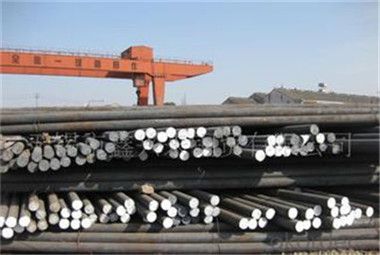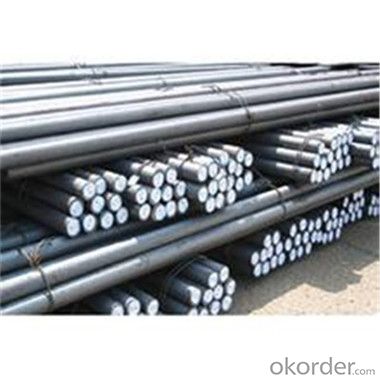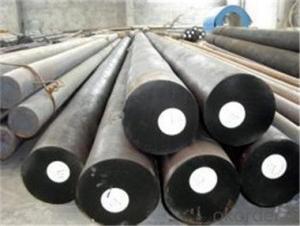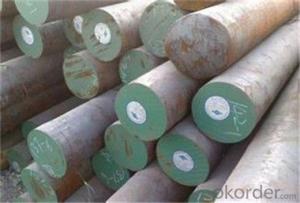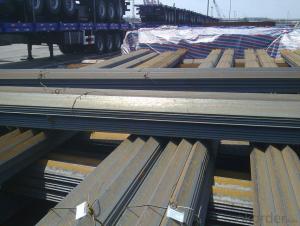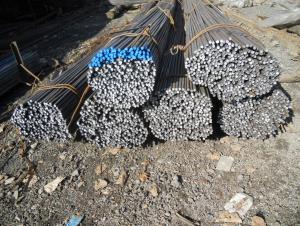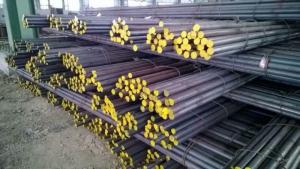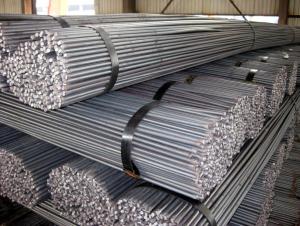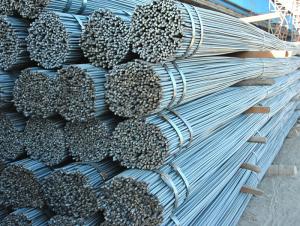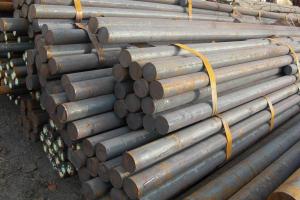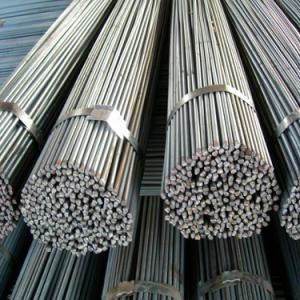Hot Rolled Carbon Steel Round Bar MS Bar Supplyer by CNBM
- Loading Port:
- Tianjin
- Payment Terms:
- TT OR LC
- Min Order Qty:
- 55 m.t.
- Supply Capability:
- 2000000 m.t./month
OKorder Service Pledge
OKorder Financial Service
You Might Also Like
Description of steel round bar:
1. Commodity: Round steel bar
3. Technical: Hot rolling
2. Length: Min. 5.8meter, according to requirement.
3. Diameter: 16mm-250mm
5. Packing: In Bundle or according to your requirements.
Festures of steel round bar:
Description : Steel Bar/Stainless Steel Round Bar/Alloy Steel Round Bar/Carbon Steel Bar
Stainless Steel Bright Bar/Stainless Steel Peeled Bar/Stainless Steel Polishing Bar
Diamater:
1 Hot rolled round bar diameter from 5.5mm to 110mm
2.Hot forged round bar diameter from 110mm to 400mm
3.Cold drawn round bar diameter from 2.0mm to 60mm
Specifications of steel round bar:
Length: standard 6m,9m,12m, or as customers' requirement
Surface: Black, polished, grinded, ,Bright, Turn smooth(Peeled),Brush,Mill,Pickled
Process:Hot rolled,cold drawn,forged
Packing: In bundle, tied by steel straps, covered with protecting film Use wooden box, fill with foam to keep the surface from damaging
Images of steel round bar:
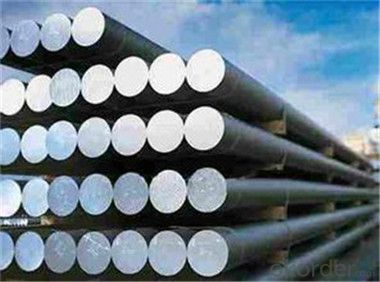
FAQ:
1. What is your main market?
We mainly export to Asia such as Japan,Korea,Thailand and North America and Middle East.
2. What payment term do you accept?
Payment: T/T or L/C at sight.
3.Why do you choose to cooperate with us?
We have over10 years experience in this business so we are able to provide you the high quality products with the best price.
- Q: How do you calculate the weight of a steel round bar based on its length and volume?
- In order to determine the weight of a steel round bar based on its length and volume, it is necessary to have knowledge of the steel's density. The density denotes the mass per unit volume of the material. The weight can be calculated using the following formula: Weight = Volume × Density To begin, one must calculate the volume of the steel round bar. The volume of a cylinder, which is the shape of a round bar, can be determined using the following formula: Volume = π × (Radius)^2 × Length The value of π is a mathematical constant approximately equal to 3.14, and Radius represents the radius of the round bar. Once the volume is obtained, it can be multiplied by the density of the steel to find the weight. It is important to note that the density of steel may vary depending on the specific type being used. For instance, mild steel has a density of approximately 7850 kg/m³. Therefore, the weight of the steel round bar can be calculated as: Weight = Volume × Density For example, let us consider a steel round bar with a length of 1 meter and a radius of 0.5 meters. To calculate the weight, we first need to determine the volume: Volume = π × (0.5)^2 × 1 Volume = 0.7854 m³ Next, we multiply the volume by the density of steel: Weight = 0.7854 m³ × 7850 kg/m³ Weight = 6171.79 kg Hence, the weight of the steel round bar would be approximately 6171.79 kg.
- Q: How do steel round bars compare to cast iron bars?
- Steel round bars are generally considered to be stronger and more durable than cast iron bars. Steel has a higher tensile strength and can withstand greater loads and stress without deforming or breaking. Additionally, steel is more resistant to corrosion and has a higher melting point compared to cast iron. Another advantage of steel round bars is their versatility. Steel can be easily machined, welded, and formed into various shapes, making it suitable for a wide range of applications. Cast iron, on the other hand, is brittle and difficult to work with. It has limited malleability and tends to crack or chip under stress. However, cast iron bars have their own unique properties that make them suitable for specific applications. Cast iron is known for its excellent heat retention and distribution, making it ideal for applications such as cookware and engine blocks. It also has good vibration damping properties, which can be beneficial in certain industrial applications. In summary, while steel round bars are generally considered to be superior in terms of strength, durability, and versatility, cast iron bars have their own specific advantages in certain applications. The choice between the two will ultimately depend on the specific requirements and conditions of the intended use.
- Q: Can steel round bars be used in the production of gears?
- Yes, steel round bars can be used in the production of gears. Steel round bars are often used as a raw material in gear manufacturing due to their high strength, durability, and ability to withstand heavy loads and high temperatures. The round bars can be machined or forged into the desired gear shape, ensuring precise dimensions and accurate teeth profiles. Steel round bars also offer excellent wear resistance and can be heat-treated to further enhance their mechanical properties, making them a suitable choice for various types of gears, including spur gears, helical gears, bevel gears, and worm gears.
- Q: What are the advantages of using nickel-tin alloy steel round bars?
- There are several advantages of using nickel-tin alloy steel round bars. Firstly, the addition of nickel improves the corrosion resistance of the steel, making it suitable for applications in harsh and corrosive environments. Secondly, tin improves the machinability and workability of the steel, allowing for easy shaping and fabrication. Additionally, the alloy steel round bars exhibit high strength and excellent mechanical properties, making them ideal for structural applications that require durability and reliability. Lastly, the combination of nickel and tin enhances the overall performance and longevity of the steel, making it a cost-effective choice in various industries such as automotive, aerospace, and marine.
- Q: How do steel round bars compare to plastic or composite bars?
- Steel round bars are generally considered to be stronger and more durable compared to plastic or composite bars. They have higher tensile strength, can withstand heavier loads, and are less prone to bending or breaking. Additionally, steel bars offer better resistance to harsh weather conditions, corrosion, and fire. However, plastic or composite bars can be more lightweight and cost-effective, making them suitable for certain applications where weight or budget is a concern. Overall, the choice between steel, plastic, or composite bars depends on the specific requirements of the project or application.
- Q: What is the tolerance for length in steel round bars?
- The tolerance for length in steel round bars can vary based on specific manufacturing standards and requirements. Typically, the tolerance is defined as the maximum allowable deviation from the desired length and can be expressed as a percentage or specific measurement in millimeters or inches. Various international standards organizations, such as ASTM or ISO, may have their own guidelines for steel round bar tolerances. These standards ensure consistent and reliable measurements across the industry. In practice, tolerances for steel round bar length can range from tight tolerances of a few millimeters for precision applications to looser tolerances of several centimeters for general-purpose use. It is important to consider that the tolerance may also depend on the size and diameter of the bar. Smaller diameter bars may have tighter tolerances due to the challenges in manufacturing and accurately measuring longer lengths. Ultimately, the specific tolerance for steel round bar length should be determined based on the intended application and relevant industry standards or customer specifications.
- Q: What are the advantages of using nickel-chromium-silicon alloy steel round bars?
- Using nickel-chromium-silicon alloy steel round bars offers several benefits: 1. Exceptional heat resistance: These round bars can withstand extreme temperatures up to 1200°C without compromising their strength or structure. This makes them ideal for applications in high-temperature environments. 2. Effective against corrosion: The alloy steel round bars exhibit good resistance to corrosive substances like acids and alkalis. This makes them suitable for industries such as chemical processing, oil and gas, and marine applications. 3. Strong and durable: These round bars possess high tensile strength and toughness, enabling them to endure heavy loads and resist deformation. They are known for their exceptional durability, ensuring a long service life even in demanding conditions. 4. Impressive mechanical properties: The alloy steel round bars display excellent mechanical properties, including ductility, impact resistance, and fatigue strength. This makes them suitable for applications requiring reliability and high performance, such as structural components, machine parts, and tools. 5. Easy to fabricate: The nickel-chromium-silicon alloy steel round bars can be machined, welded, and formed into various shapes and sizes with ease. This grants manufacturers greater design flexibility and simplifies fabrication processes. 6. Cost-effective solution: Despite their numerous advantages, nickel-chromium-silicon alloy steel round bars are relatively cost-effective compared to other high-performance materials. Their longevity and resistance to wear and tear reduce the need for frequent replacements and maintenance, making them a cost-efficient choice in the long run. Overall, the advantages of nickel-chromium-silicon alloy steel round bars make them an excellent option for applications requiring high temperature resistance, corrosion resistance, strength, durability, and ease of fabrication.
- Q: What are the different types of steel round bar profiles?
- There are several different types of steel round bar profiles available in the market. Some of the most common profiles include: 1. Plain Round Bar: This is the most basic and commonly used profile. It is a solid cylindrical bar with a smooth surface and uniform diameter throughout its length. 2. Deformed Round Bar: This type of round bar has deformations or ribs along its surface. These deformations provide better bonding with concrete when used in reinforced concrete structures, making it ideal for construction applications. 3. Hollow Round Bar: As the name suggests, this profile has a hollow center. It is often used in industries where weight reduction is important or where the round bar needs to be used as a conduit for fluids or gases. 4. Threaded Round Bar: This profile has threads along its length, allowing it to be easily screwed into other components. It is commonly used in applications where secure fastening or adjustability is required. 5. Half-Round Bar: This profile has a flat side and a rounded side, giving it a semi-circular shape. It is often used in decorative applications, such as handrails, where a sleek and aesthetically pleasing appearance is desired. 6. Square Bar: Although not strictly a round profile, square bars are often included in this category. These bars have four equal sides and are commonly used in applications where higher torsional strength is required. 7. Hexagonal Bar: Similar to square bars, hexagonal bars have six equal sides. They are often used in applications where high torque resistance is needed or when a distinctive appearance is desired. These are just some of the different types of steel round bar profiles available. The choice of profile depends on the specific application requirements, such as structural strength, bonding capabilities, or aesthetic considerations.
- Q: Can steel round bars be painted or coated?
- Yes, steel round bars can be painted or coated with various types of protective coatings to enhance their durability and prevent corrosion.
- Q: What is the maximum copper content allowed for steel round bars?
- The maximum copper content allowed for steel round bars varies depending on the specific grade and industry standards. In general, copper is considered an alloying element in steel and is typically added in small amounts to enhance certain properties. The maximum allowable copper content for most steel round bars is typically around 0.50% to 1.00%. However, it is important to note that this can vary depending on the specific application and grade of steel being used. It is recommended to consult the relevant industry standards or specifications for the specific steel grade and application to determine the maximum copper content allowed.
Send your message to us
Hot Rolled Carbon Steel Round Bar MS Bar Supplyer by CNBM
- Loading Port:
- Tianjin
- Payment Terms:
- TT OR LC
- Min Order Qty:
- 55 m.t.
- Supply Capability:
- 2000000 m.t./month
OKorder Service Pledge
OKorder Financial Service
Similar products
Hot products
Hot Searches
Related keywords



